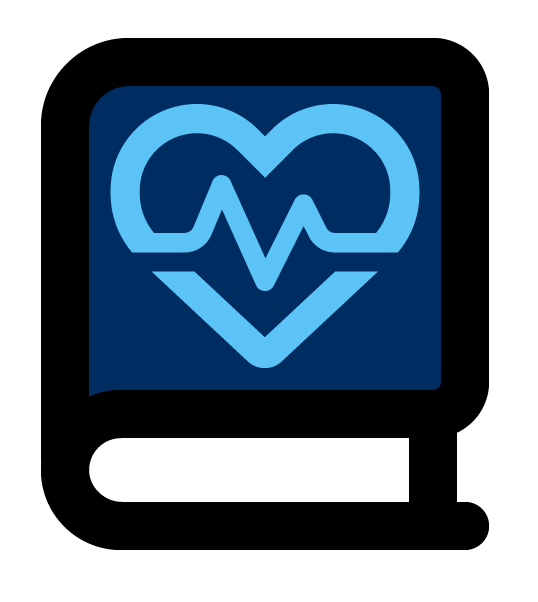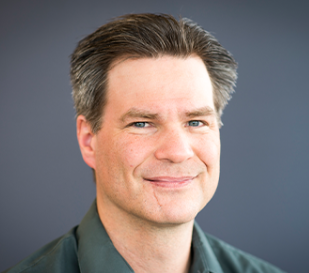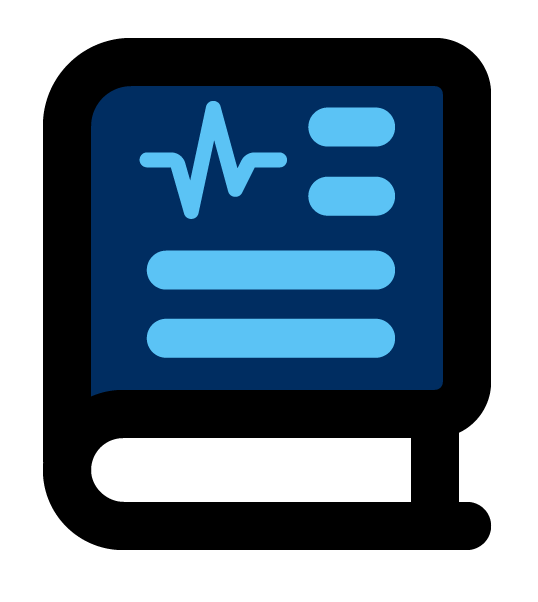Greetings, Dear Student!
This course guide contains information for the 4th year online EKG interpretation course. This is an exciting opportunity that allows you to have flexibility while learning independently and managing your own time. The course includes resources that will allow you to review electrocardiography basics including the normal EKG, then move on to common EKG abnormalities, then to progress to interpretation of more complex abnormalities including the EKG showing multiple abnormalities and arrhythmias.
Note
The abbreviations for electrocardiogram, EKG and ECG, will be used interchangeably throughout these pages. This is not meant to cause confusion. Both abbreviations are perfectly correct and proper.
We would like to gratefully acknowledge Dr. Alex Franke (WSU Elson S. Floyd College of Medicine class of 2021) and Dr. Dawn DeWitt (Senior Associate Dean, CIPHERS, and Year 4 Director) for their invaluable contributions to the course design!
Go Cougs!
Expectations
This 2-credit 4th-year elective is based on the use of 2 primary resources and a third supplemental resource listed below, which were carefully selected for their clinical relevance, up-to-date content, and interactive design, allowing the student to apply their learning to the interpretation of the EKG and to the diagnosis and treatment of the patient. The two primary resources may be utilized roughly over the course of a week each, and the third supplemental resource is a prerecorded 47.5-minute lecture that may be viewed at any time during the course. These are linked below, as well as in a sample calendar of activities for the course in the next section of this guide.
Resources for the course

12-Lead EKG Confidence: A Step-By-Step Guide
We have recreated here (on the Medicine Digital Learning site) the materials found in the first resource, 12-Lead EKG Confidence: A Step-By-Step Guide (with permission), 3rd ed., 2015, to make it easier for students to work through the material. (It can also be found as an eBook available in our library.)
This resource has a workbook design that lends itself to active learning, as students work through interpretation of EKGs ranging from normal EKGs, simple EKGs of common problems, to more complex EKGs showing challenging arrhythmias or multiple abnormalities. For most students, this resource should be perfectly level-set to work through during the first week of the course in a systematic manner.
If you are significantly challenged by the content within, go back to the basics before proceeding by reviewing Chapter 4 of Lilly’s Pathophysiology of Heart Disease, the ECG Shorts series, or Dale Dubin’s Rapid Interpretation of EKGs (available through a WSU library search).
Please note that while these latter resources are all excellent basic reviews, they lack sufficient depth to provide the background you will need to launch into EKG interpretation through case-based EKG studies on your own, so after reviewing one or more of these latter resources, go back to complete your work with 12-Lead EKG Confidence.
- Work through the worksheets at the end of each chapter in the order presented in the Sample 2-week rotation schedule shown below. Click the provided answers to see how your answers compare.
- If you struggle with EKGs in a specific chapter or section, go back and review the text in the pertinent chapter or section.
- If you are still struggling, consider reviewing materials such as chapter 4 in Lilly’s Pathophysiology of Heart Disease and/or Osmosis videos pertinent to that EKG element or topic.
- Test your knowledge of the basic concepts with the Section reviews prior to moving on to the next week’s material.
- We strongly recommend using a hand-held caliper when you interpret a paper ECG. Many subtle questions in ECG interpretation can be answered with use of a caliper.
- Many of the images can be enlarged by tapping on them.
-
The second resource, Amal Mattu’s ECG Weekly Workout is an excellent online compendium of EKG Cases of the Week, including brief patient vignettes, questions regarding the diagnosis and management of the patient, and recorded lectures with detailed discussion of the salient points.
- The College of Medicine has provided all MS4s with access to ECG Weekly Workout. If you don’t know your password, you can reset it at this link using your WSU email address.
- Additional information about ECG Weekly can be found on the MedTech website here. If you have any difficulties logging in or accessing cases, please contact MedTech.
- You may review weekly cases in any order you wish.
- Proceed through the Case of the Week by providing your interpretation of the EKG shown at the top of the page in the context of the clinical information given, then answer the questions listed below the EKG.
- No need to write your answers to the questions down, unless that helps you to organize your thoughts.
- Then view the video. The answers to that case will be explained in the video.
- Multiple other cases may be presented in the video, with excellent teaching points given along the way, along with detailed graphic analysis of the waveforms.
- Review the key teaching points for each of the ECGs shown in the video, which are summarized in the link at the bottom of the page.
- Mark the Case of the Week as complete at the bottom of the page in order to move efficiently through the cases.
-
ECG Diagnosis of Atrial Fibrillation: A Primer for Medical Students
This third supplemental resource was added in order to address concerns of students needing more clarity regarding the EKG diagnosis of atrial fibrillation AF, and how to differentiate AF from other atrial tachyarrhythmias. This 47.5-minute prerecorded lecture is included below.
-
Optional Links and Resources
You may also take advantage of the other materials contained within the recommended references. There is no required textbook for the rotation. Some resources that may be helpful are linked below.
There is a reason I constantly reference this outstanding resource to our students. It is written by medical students for medical students, and strikes just the right balance between concise and deep, and providing the medical student with what they need to know. This chapter exemplifies that balance, providing an excellent overview of ECG in just 38 pages. If you feel weak in your ECG skills, consider reviewing this chapter in detail prior to beginning the course.
Rapid Interpretation of EKGs, by Dale Dubin
Unfortunately, this book is not available as an e-book in our library, but is a very concise and excellent resource for the beginner, if you have the means to purchase a paper copy. It was what we used in our first year of medical school to get beyond the mystery, and get into actually understanding how to interpret an EKG. It could easily be digested over a weekend if you are a quick reader. Your course directors also have one copy of this book, which may be checked out for one week on a first-come, first-served basis.
This book provides a generally excellent introduction to most introductory 12-lead ECG interpretation concepts, but students should not rely on it as a sole resource as others listed provide a deeper explanation of complex topics.
The Only EKG Book You’ll Ever Need, 9th ed., 2019
This more detailed resource is a reference textbook that fulfills its claim in the title, and includes 2 or 3 cases at the end of each chapter to illustrate learning points, with an additional 22 cases in the last chapter of this 400 page book.
ABC of Clinical Electrocardiography, 2ed, 2008
While significantly shorter than 12-Lead EKG Confidence, this resource is more condensed, and may take more time to digest page by page. There is excellent detail with regards to the ECG diagnosis of arrhythmias and other disease processes, and again the resources is loaded with great examples.
This series takes the student through a rapid progression of highly relevant material, beginning with the basics of recording an ECG through the challenging topic of diagnosing cardiac arrhythmias using ECG.
- Viewing ECG Academy basic and advanced videos.
- Completing weekly quizzes (ECG Quiz 50 question quizzes).
- Self-assessing ECG skills using the Life in the Fast Lane top 100 EKGs.
Tips and tricks
While this course is an “independent” case study course, completion of the learning materials is an important commitment. You should plan a “work-day” schedule that includes daily goals (e.g., completing X chapters/case modules per day). A sample 2-week rotation schedule below may help you to stay on task. The goal is to complete the recommended chapters each day in the first week, then to complete approximately 10–20 “ECG Cases of the Week” case modules per day in the second week. Note that these modules will have more than one ECG to review and diagnose. You will also need some independent study time to work on the questions embedded within the modules, to research questions of your own relating to the cases, and/or to review foundational aspects of cardiac electrophysiology and electrocardiography.
Sample 2-week rotation schedule
While this elective can be taken over a longer period of time—during interview season, for example—below is a sample 2-week schedule to aid the student with time-management in working through the course materials.
12-Lead EKG Confidence: A Step-By-Step Guide (specific chapters and sections are noted below). Worksheets are located at the end of most chapters. Then test your knowledge at the end of most sections. Answers are provided for self-assessment.
ECG Diagnosis of Atrial Fibrillation: A Primer for Medical Students
|
Monday |
Tuesday |
Wednesday |
Thursday |
Friday |
|---|---|---|---|---|
|
EKG Measurements |
Atrial Arrhythmias (Cha. 7) |
Junctional Rhythm, Heart Block, and Pacemakers (Cha. 9) |
Complete Arrhythmia Cases |
|
|
Other Nonischemic Diseases |
Ventricular Arrhythmias (Cha. 8) |
(Sect. VIII) |
||
|
|
|
ECG Diagnosis of Atrial Fibrillation: A Primer for Medical Students |
Complete formative quiz and mid-rotation check-in form. Reminder to book a 30-minute one-on-one appointment with Dr. Anderson or Dr. Hodges. |
Amal Mattu’s ECG Cases of the Week (“ECG Weekly Workout”)
|
Monday |
Tuesday |
Wednesday |
Thursday |
Friday |
|---|---|---|---|---|
|
10–20 weeks’ worth of cases |
10–20 weeks’ worth of cases |
10–20 weeks’ worth of cases |
10–20 weeks’ worth of cases |
5–10 weeks’ worth of cases |
|
EKG Examination (open book) |
||||
|
Notify Drs. Hodges and Anderson if you have scored less than 70% on your examination in place of final course review. |
Reminder
Book a 30-minute one-on-one appointment with
Dr. Hodges or Dr. Anderson during your mid-course review.
Book a 30-minute appointment.
Book a 30-minute appointment.
Feedback
Please send feedback on the course to Dr. Anderson.





